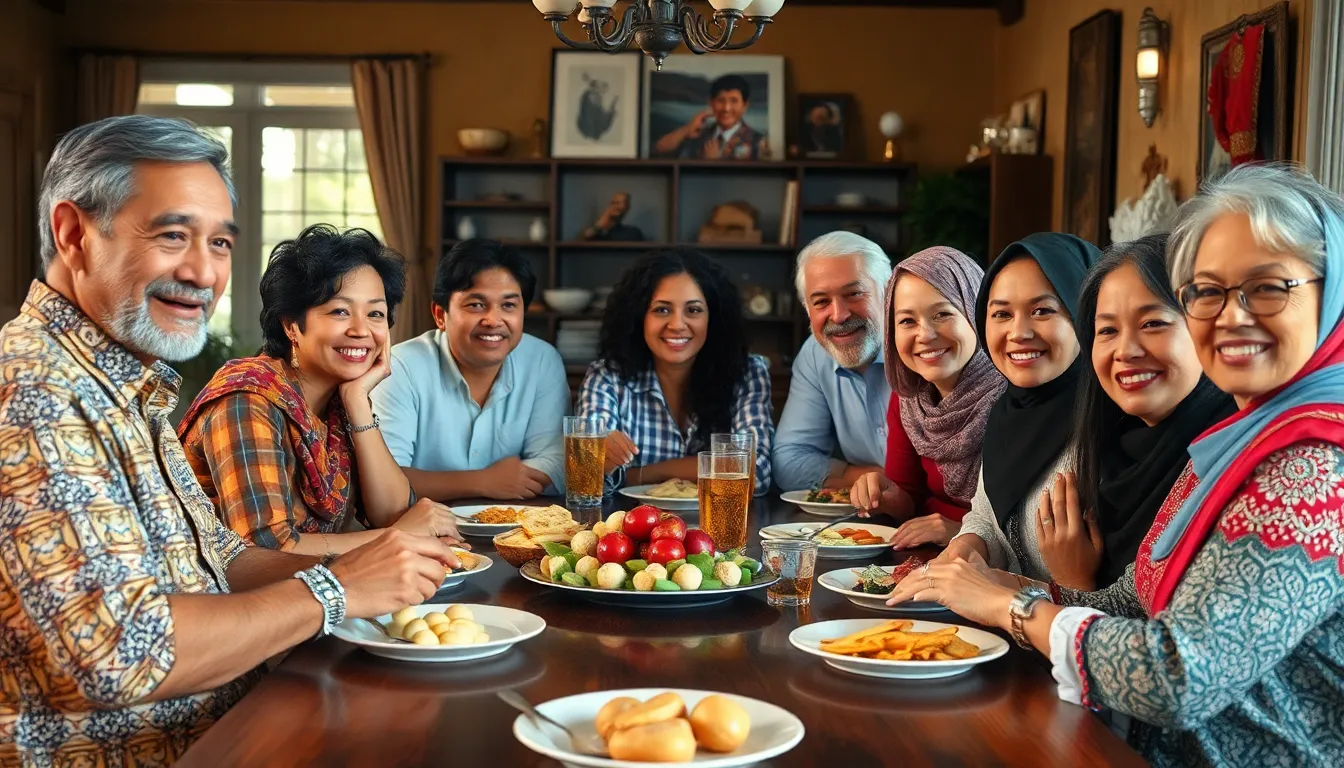Navigating the world of cultural etiquette can feel like trying to dance the tango while wearing roller skates. One wrong move and you might find yourself stepping on toes—both literally and figuratively. Whether it’s bowing in Japan or avoiding the infamous finger-point in many cultures, understanding these nuances can save you from potential faux pas.
In a world that’s more interconnected than ever, mastering cultural etiquette isn’t just a nice-to-have; it’s a must-have. It opens doors, builds bridges, and helps forge genuine connections. So buckle up and get ready to dive into some essential tips that’ll not only keep you from looking like a clueless tourist but might also earn you a few laughs along the way. After all, who wouldn’t want to impress the locals while keeping things light-hearted?
Table of Contents
ToggleUnderstanding Cultural Etiquette
Understanding cultural etiquette plays a critical role in promoting positive interactions. Recognizing various behaviors is essential when communicating across cultures. For instance, in Japan, bowing signifies respect, while in Western cultures, a firm handshake conveys confidence. Adjusting these behaviors according to cultural norms fosters better relationships.
Observing local customs allows for smoother interactions. Greetings can vary widely; while some cultures prefer formal introductions, others embrace casual approaches. Familiarity with these differences helps avoid unintentional rudeness.
Respecting personal space also matters greatly. In some cultures, close proximity is a sign of warmth; in others, it may be intrusive. Keeping awareness of these boundaries enhances comfort during conversations.
Dining etiquette varies significantly worldwide. In many African countries, sharing food signifies hospitality, whereas in Western nations, using utensils appropriately is vital. Being mindful of dining customs can prevent misunderstandings and enhance social experiences.
Gestures carry diverse meanings across cultures. For example, the thumbs-up gesture is positive in the U.S. but can be offensive in parts of the Middle East. Familiarizing oneself with gestures leads to more respectful exchanges.
Adhering to punctuality is often a reflection of cultural values. Some cultures view promptness as a sign of respect, while others adopt a more relaxed approach to time. Understanding these variations can influence meeting dynamics.
While navigating cultural etiquette may seem daunting, a willingness to learn and adapt opens doors to meaningful connections. Embracing these principles fosters an environment of mutual respect and understanding.
Importance of Cultural Etiquette Tips


Understanding cultural etiquette plays a pivotal role in fostering effective interactions. Navigating diverse cultures enhances both personal and professional relationships, creating an environment of respect and collaboration.
Enhancing Communication
Effective communication hinges on recognizing and adapting to cultural nuances. Being aware of body language conveys respect, as gestures may hold different meanings across cultures. Eye contact, for instance, might signify confidence in one culture but imply disrespect in another. Acknowledging these differences ensures clear exchanges and minimizes the risk of misinterpretation. Additionally, mastering local greetings can make conversations more comfortable. Learning simple phrases in a native language, such as “hello” or “thank you,” demonstrates care and consideration, leaving a positive impression. Overall, cultural awareness in communication fosters trust and rapport.
Building Relationships
Building strong relationships relies heavily on cultural etiquette. Recognizing social norms, such as gift-giving customs or appropriate topics for discussion, creates an atmosphere of trust. In some cultures, sharing a meal symbolizes friendship; understanding dining etiquette enhances shared experiences. Similarly, respecting personal space varies across cultures; therefore, gauging comfort levels is essential. Taking time to understand local practices helps establish connections that transcend geographical boundaries. Engaging in cultural traditions invites collaboration and strengthens relationships. Prioritizing these aspects of etiquette reflects awareness and open-mindedness, encouraging lasting bonds.
Common Cultural Etiquette Tips
Understanding cultural etiquette enhances communication and fosters connections across diverse settings. Several key areas require attention for successful interactions.
Greetings and Introductions
Different cultures favor unique ways of greeting others. In many Asian cultures, a slight bow signifies respect, while Western countries typically opt for a firm handshake. Eye contact can indicate sincerity, though in certain regions, it might be perceived as disrespectful. Always observe local customs before engaging in introductions. Asking about someone’s name and title shows respect and acknowledges their identity. Remember that the personal space preferred may also vary; close distances are common in some cultures, while others value more distance during conversations.
Dining Etiquette
Dining customs vary significantly around the globe. In Japan, finishing all the food on your plate is considered polite, reflecting appreciation for the meal. Conversely, many Middle Eastern cultures expect guests to savor their meals and may refuse additional servings to be polite. Table manners, such as using utensils properly, differ, with some countries favoring chopsticks while others use forks and knives. In certain cultures, it’s customary to wait for the host to begin the meal before eating. Noticing these details creates a respectful dining experience and encourages positive social interactions.
Gift Giving Practices
Gift giving is a nuanced practice influenced by cultural norms. In many Asian cultures, red wrapping signifies good fortune, while in some Western countries, elaborate presentations aren’t as essential. It’s prudent to consider the occasion, relationship, and local customs when selecting a gift. Avoid giving certain items, such as knives, as they can symbolize severing a relationship. Sometimes, presenting gifts with both hands signifies respect and sincerity. Respecting these cultural norms ensures that gifts are well received and appreciated, further strengthening interpersonal bonds.
Tips for Specific Cultures
Understanding cultural nuances aids in meaningful interactions across different regions. Here are specific etiquette tips for various cultures.
Asian Cultures
Bowing is common in places like Japan, where it shows respect. Holding a conversation often involves maintaining a certain distance to ensure personal space. Eye contact can be seen as confrontational in some cultures, so it’s good to observe the other person’s body language. When dining, finishing all food on your plate signifies enjoyment in Japan, while leaving a bit can be polite in China. Gift-giving carries great significance too; wrapping gifts in red symbolizes good luck and prosperity.
European Cultures
A firm handshake is standard in many European countries, projecting confidence. Greetings often start with addressing the person’s title followed by their last name. Being punctual reflects professionalism, particularly in Germany and Switzerland. Table manners are generally formal; keeping one’s hands on the table, but not elbows, shows good etiquette. In France, saying “Bon appétit” before meals demonstrates courtesy and appreciation for the food served.
Middle Eastern Cultures
Warm greetings play a key role; using a proper title shows respect. Handshakes are common among men, but physical contact may vary based on gender norms. Offering food and drinks is customary, with rejecting initially considered polite before accepting. Guests should refrain from discussing personal matters too soon; building trust takes precedence. Dining etiquette emphasizes eating with the right hand; left hands are associated with unclean tasks in many cultures.
Understanding cultural etiquette is vital in today’s diverse world. By embracing these customs and practices, individuals can navigate social interactions more smoothly and build lasting relationships. Respecting local traditions and being mindful of gestures can foster an atmosphere of trust and collaboration.
With a little effort and willingness to learn, anyone can enhance their communication skills across cultures. This not only enriches personal experiences but also opens doors in professional settings. Ultimately, cultural awareness is a powerful tool that promotes mutual respect and understanding, paving the way for meaningful connections.





